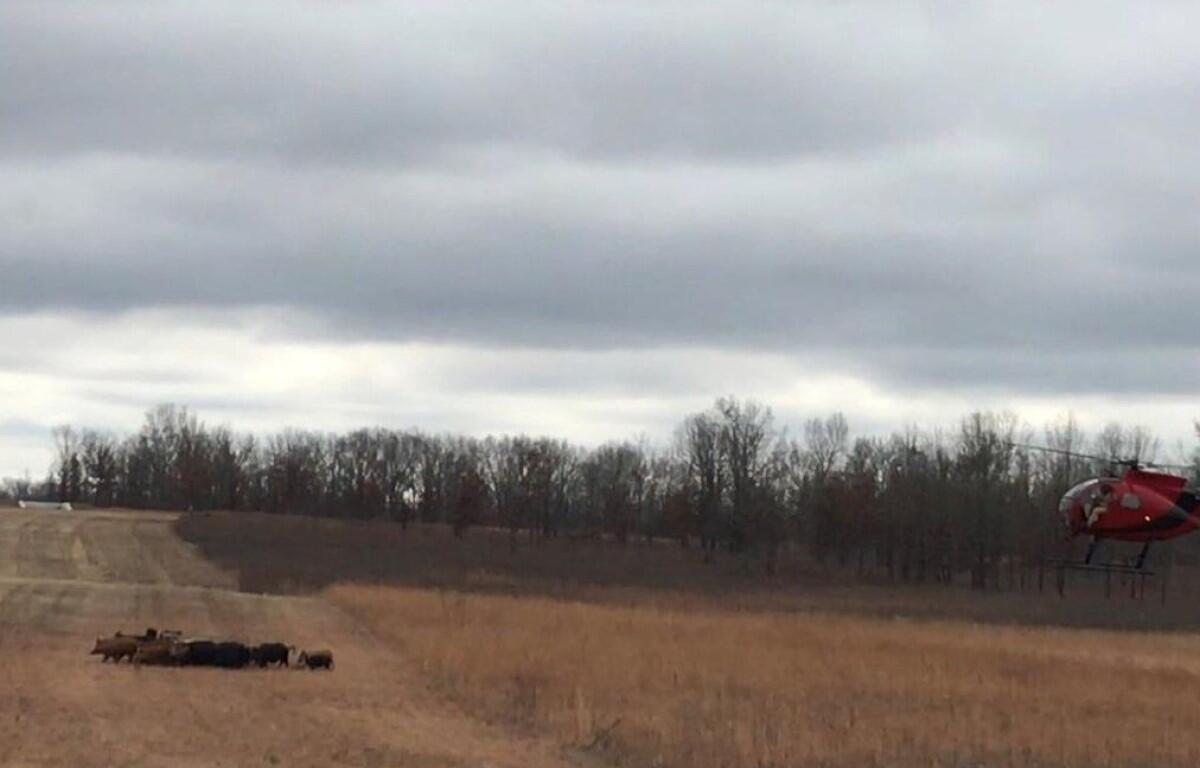FORT CAMPBELL, KY – Feral hogs have been rooting through Fort Campbell for more than 15 years, but the installation is closer than ever to eliminating them thanks to a partnership with the U.S. Department of Agriculture.
USDA and the Directorate of Public Works Fish and Wildlife Program conducted their third annual hog removal in the installation’s rear training area from Dec. 27-28, dispatching 21 feral hogs through aerial gunning.
“When the ranges are shut down around the holidays, that’s the best time for us to go in and do something like this,” said Jonathan Mills, hunting and fishing program manager and integrated pest management coordinator, DPW. “That gives us better access to where the hogs are typically residing on Fort Campbell, which is in the north and south large arms impact area.”
Mills said DPW was aware of 27 hogs remaining on the installation before they conducted the operation. The USDA sent a regional helicopter owned and operated by its employees and was able to clear out all but six of them.
“We’re hoping between a potential second flight and some trapping that continues over the spring and summer, those remaining six – assuming there are no others – can be removed,” he said.
The first operation in 2019 eradicated 196 hogs, and Mills said the drop in numbers each year suggests the removal efforts are working. Once DPW is no longer tracking any feral hogs, the plan is to move into a monitoring phase because their resurgence could prove costly.

What’s the problem with hogs?
“(Feral) hogs are invasive and cause a lot of problems on post, and that includes the ranges,” said Capt. Sarah Bohac, First Year Graduate Veterinary Education, or FYGVE, intern, Fort Campbell Veterinary Center. “When they root, they can destroy electrical wiring and do a lot of damage to our training facilities. That’s a lot of money for the Army, and that’s a lot of delays or time where we’re not training as we should.”
Rooting can also damage agricultural spaces on and off post. Feral hogs have been known to visit nearby farms while searching for their next meal, and they can bring along diseases that are infectious to livestock.
One of the USDA’s responsibilities during removal operations is to test the feral hogs for diseases. That means pilots will attempt to drive hogs out of the impact area because the unexploded ordnance make it too dangerous to collect blood and tissue samples.
“We’re mainly testing for pseudorabies, classical swine fever and brucellosis,” Bohac said. “Pseudorabies and classical swine fever are not zoonotic, so they can’t be transferred to humans, but what they can do is wipe out our agriculture farms of domestic pigs and swine. That can be severely detrimental to those farmers, and it can compound to us not having meat or the prices going up.”
Brucellosis can be transmitted to humans through direct contact with an infected hog or its bodily fluids. Bohac said disease can cause illness, miscarriages or fertility problems if contracted.
How did they get here?
Coming into contact with wild hogs on the installation was unheard of for decades, especially since the species is not native to North America.
“They were brought here by Europeans, and a lot of the populations in Tennessee were originally established in the Appalachian Mountain chain in the early 1900s,” Mills said. “In 1999 the state actually reclassified the hogs as a large game animal that you could pursue, and when they did that, folks decided they wanted to be able to hunt on their own land. Sportsmen started trapping and relocating them to either their private land or local wildlife management areas, and you started seeing all these isolated populations popping up.”
Mills said hunters likely brought the first hogs onto Fort Campbell around 2004, though the installation was never able to confirm who was responsible. By the time the Tennessee Wildlife Resource Agency removed their classification as a big game species in 2011, hogs had become a fixture on post.
Don’t try this at home
While soldiers and families may feel compelled to help clear out the remaining feral hogs, Mills said there are regulations against hunting them on post – even incidental kills during deer season.
“If you were to shoot into a group of hogs, you may actually be hindering the removal because it will split those sounders, which is what we call the family groups,” he said. “It makes it much harder to remove and trap them after that point, so we really don’t want people shooting them.”
Harvesting feral hogs is also the easiest way for people to contract any diseases they may be carrying, so community members are encouraged to report sightings to Mills’ office at 270-798-9854 or the iSportsman line at 270-798-9824.


